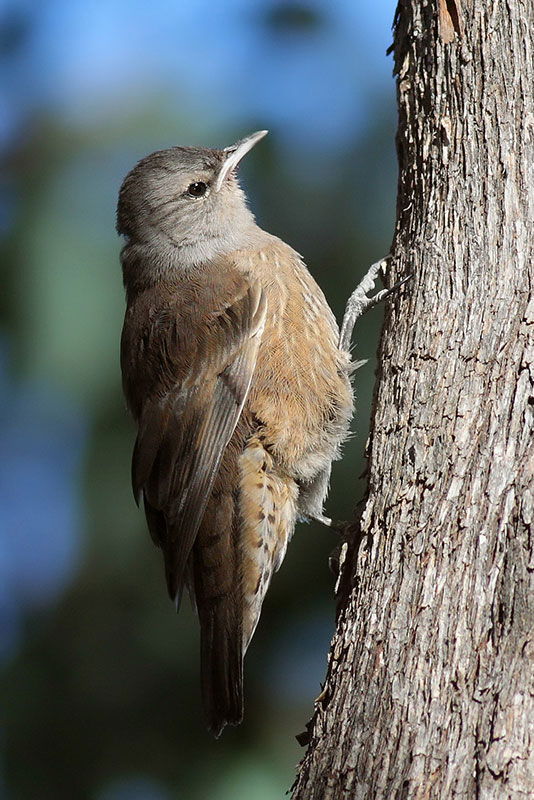Meet a Treecreeper!
Photo by sunphlo, CC BY-SA 2.0, via Wikimedia Commons
Leporidae
by Inspector Barry Mins on January 30, 2024Hey kids, welcome back to our series on the mysteries of created kinds.
A Cormorant Update
First, a quick update on Cormelius. One of my coworkers took this video a few weeks ago. As you can see, despite his wing injury, he gets around very well in the water and seems to be enjoying life. In this video, he is hunting for food, and you will notice he seems quite comfortable swimming underwater as well as above. We’re going into the coldest time of year as I write this, so Cormelius will probably spend a lot of time sunning himself to dry off and stay warm in the next month. We are much further north than his normal winter range.
Can You Guess This Kind?
Now, let’s move on to investigate our kind for the week.
These birds love to live on tree trunks.
This kind has a very limited range, with most species found in Australia, and just one found in New Guinea. They are, however, fairly abundant in this range, with none of the species being endangered or threatened. The birds are fairly nondescript, with dull brown, black, white, and gray plumage. They are sexually dimorphic, but the differences between males and females are not in your face unlike other birds, like cardinals.1 These birds love to live on tree trunks, so it should be no surprise that they prefer woodland habitats.2 They have the ability to control their body temperature, lowering during rest periods by a substantial amount.3
This kind has a widely varied diet. They preferentially eat insects but will also take nectar,4 tree sap,5 and fungi6 where it is available. To get their insects, they prefer simply foraging over tree trunks, but they will occasionally drill into dead wood to dig out their prey.7
This kind breeds cooperatively. What this means is that multiple members of a species work together to raise a pair’s young, rather than each set of parents caring for their own chicks. Often, the larger the breeding group, the better chance of success but habitat also contributes.8 Some species will breed in pairs, if necessary, but the preference is to have helpers.9
Has anyone figured it out yet? This week’s kind is the Climacteridae—the Australasian treecreeper kind. Stay tuned for next week when we go looking for a fleet of foot mammal kind.
Try out this fun word search!
Clue
Your clue for the week is:
This kind has horns and is frequently seen on nature documentaries, often as prey for big cats.
Ask a Question
Have you ever had a question about created kinds but didn’t know who to ask? Have you ever wanted to learn more about your favorite kind? Well, now you can! You can ask me, Inspector Barry Mins, a question! Have your parents help you fill out this form, and you might get your question answered in my column! If you have any questions about created kinds, feel free to send them my way!
Footnotes
- Gary Luck, “Plumage and Size Variation in Adult and Juvenile Rufous Treecreepers Climacteris rufa,” Corella 23, no. 4 (1999): 77–82, https://absa.asn.au/wp-content/uploads/2014/12/C234077.pdf.
- Gary Luck, “The Habitat Requirements of the Rufous Treecreeper (Climacteris rufa). 1. Preferential Habitat Use Demonstrated at Multiple Spatial Scales,” Biological Conservation 105 (2002): 383–394, https://www.researchgate.net/profile/Gary-Luck/publication/223948166_The_habitat_requirements_of_the_rufous_treecreeper_Climacteris_rufa_1_Preferential_habitat_use_demonstrated_at_multiple_spatial_scales/links/5a8f9746aca2721405602d27/The-habitat-requirements-of-the-rufous-treecreeper-Climacteris-rufa-1-Preferential-habitat-use-demonstrated-at-multiple-spatial-scales.pdf.
- Yaara Aharon-Rotman, John McEvoy, Christa Beckmann, and Fritz Geiser, “Pronounced Daily Heterothermy in the White-Throated Treecreeper Cormobates leucophaea,” Journal of Ornithology 165 (2023): 241–245, https://link.springer.com/article/10.1007/s10336-023-02092-6.
- Clifford Frith, “Photographic Evidence of Nectar-Feeding by the White-Throated Treecreeper ‘Cormobates leucophaea,’” Australian Field Ornithology 26, no. 3 (2009): 103–104, https://search.informit.org/doi/abs/10.3316/INFORMIT.525413505152744.
- G. Maurer, C. N. Maurer, and L. T. Reaney, “White-Throated Treecreeper Cormobates leucophaea Feeding on Bracket Fungus,” Australian Field Ornithology 34 (2017): 10–11, https://afo.birdlife.org.au/afo/index.php/afo/article/viewFile/2067/2078.
- A. B. Rose, “White-Throated Treecreeper ‘Cormobates leucophaeus’ Feeding on Sap from a Red Bloodwood ‘Corymbia gummifera,’” Australian Bird Watcher 18, no. 3 (1999): 131, https://search.informit.org/doi/abs/10.3316/INFORMIT.453824666591171.
- A. Weekes, D. B. Lindenmayer, and R. B. Cunningham, “A Study of the Foraging Ecology of the White-Throated Treecreeper (Cormobates leucophaeus),” Emu 107, no. 2 (2006): 135–142, https://www.publish.csiro.au/mu/MU06040.
- Gary Luck, “Determining Habitat Quality for the Cooperatively Breeding Rufous Treecreeper, Climacteris rufa,” Austral Ecology 27 (2002): 229–237, https://doi.org/10.1046/j.1442-9993.2002.01173.x.
- Richard Noske, “Cooperative Breeding by Treecreepers,” Emu 80, no. 1 (1980): 35–36, https://www.researchgate.net/profile/Richard-Noske/publication/263001619_Cooperative_breeding_by_treecreepers/links/560af71208ae1396914cf008/Cooperative-breeding-by-treecreepers.pdf.
- © 2024 Answers in Genesis
- Privacy Policy
- Contact
- About


